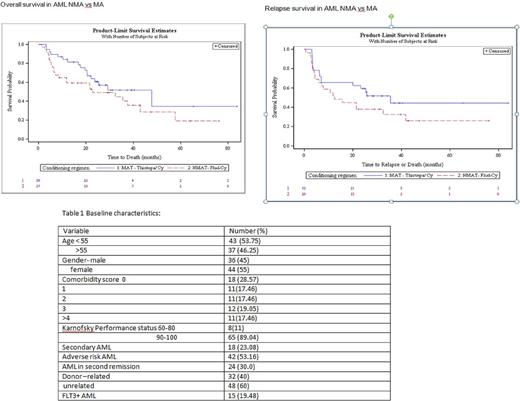Abstract
Introduction:
Nonmyeloablative (NMA) regimens allow HSCT for many otherwise ineligible patients with Acute Myeloid Leukemia (AML). NMA regimens are generally better tolerated with lower rates of toxicity than Myeloablative (MA) regimens and have comparable outcomes(S M Luger et al 2012.). Our institutional practice has been to offer NMA conditioning regimens to patients > 60 and patients up to 75 years of age. Previous studies have combined various agents with Fludarabine as part of NMA conditioning (Bacigalupo et al . 2009). In the absence of prospective randomized studies, head to head comparison between various regimens have been largely limited to retrospective studies and included heterogenous groups of patients.
Methods:
We retrospectively analyzed 80 consecutive AML patients who underwent non myeloablative Fludarabine/Cyclophosphamide (n=38) or myeloablative Thiotepa/ Cyclophosphamide (n=42) conditioning followed by allogeneic HSCT between March 2010 and July 2016. Analysis was conducted using proportional hazards regression accounting for competing risk for disease free survival (DFS), Transplant related mortality (TRM) and overall survival (OS) with different variables as a covariate.
Results:
The median age at transplant was 53.2 years, median duration of follow up was 25 months, 95% (n=76) patients had high risk features defined as disease in 2nd or 3rd Complete remission, adverse risk disease, secondary AML or required >1 induction therapy, 46.2 % (n=37) patients were older than 55 and 53.1% (n=42) had adverse risk disease. The median age at transplant for NMA group was 60.3 years and that for MA group was 42.8 years. Remission was maintained in 60% patients (n=48) and 47% (n=37) patients remained alive during the study period. On survival analysis, relapse free survival and overall survival were comparable between two groups despite the disparity in median age between two groups by > 18 years (Figure 1 & 2). Transplant related mortality (TRM) increased with increasing age at transplant, was higher in patients with secondary AML (Hazards ratio 4.9, 95% Confidence Interval 1.4-17.1, p=0.01) and patients treated with Fludarabine/Cyclophosphamide (HR 8.7, 95% CI 1.1- 70.5, p=0.04).
Conclusion:
Within limits of this study, non-myeloablative conditioning regimen consisting of minimal intensity Fludarabine/Cyclophosphamide was comparable to myeloablative Cyclophosphamide/Thiotepa in terms of relapse free survival and overall survival in AML especially in elderly population. Transplant Related Mortality increased with increasing age at transplant.
No relevant conflicts of interest to declare.
Author notes
Asterisk with author names denotes non-ASH members.


This feature is available to Subscribers Only
Sign In or Create an Account Close Modal